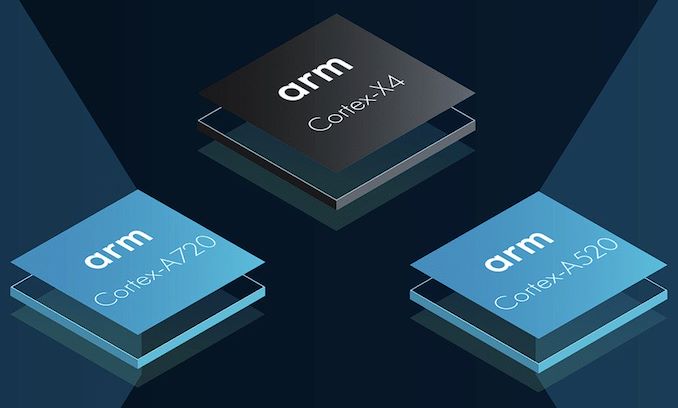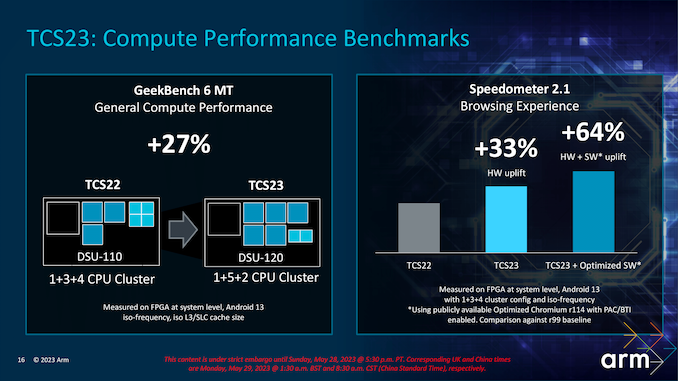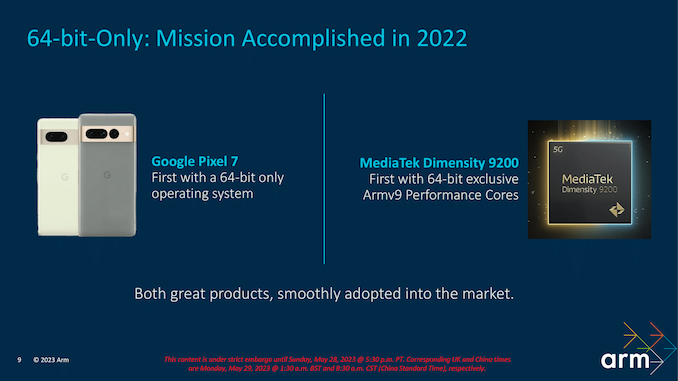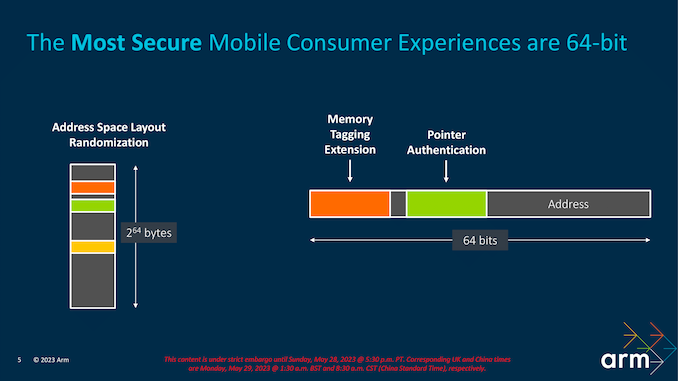Arm Unveils 2023 Mobile CPU Core Designs: Cortex-X4, A720, and A520 - the Armv9.2 Family
by Gavin Bonshor on May 28, 2023 8:30 PM EST
Throughout the world, if there's one universal constant in the smartphone and mobile device market, it's Arm. Whether it's mobile chip makers basing their SoCs on Arm's fully synthesized CPU cores, or just relying on the Arm ISA and designing their own chips, at the end of the day, Arm underlies virtually all of it. That kind of market saturation and relevance is a testament to all of the hard work that Arm has done in the last few decades getting to this point, but it's also a grave responsibility – for most mobile SoCs, their performance only moves forward as quickly as Arm's own CPU core designs and associated IP do.
Consequently, we've seen Arm settle into a yearly cadence for their client IP, and this year is no exception. Timed to align with this year's Computex trade show in Taiwan, Arm is showing off a new set of Cortex-A and Cortex-X series CPU cores – as well as a new generation of GPU designs – which we'll see carrying the torch for Arm starting later this year and into 2024. These include the flagship Cortex-X4 core, as well as Arm's mid-core Cortex-A720. and the new little-core Cortex-A520.
Arm's latest CPU cores build upon the foundation of Armv9 and their previous Total Compute Solution (TCS21/22) ecosystem. For their 2023 IP, Arm is rolling out a wave of minor microarchitectural improvements through its Cortex line of cores with subtle changes designed to push efficiency and performance throughout, all the while moving entirely to the AArch64 64-bit instruction set. The latest CPU designs from Arm are also designed to align with the ongoing industry-wide drive towards improved security, and while these features aren't strictly end-user facing, it does underscore how Arm's generational improvements are to more than just performance and power efficiency.
In addition to refining its CPU cores, Arm has undertaken a comprehensive upgrade of its DynamIQ Shared Unit core complex block, with the DSU-120. Although the modifications introduced are subtle, they hold substantial significance in terms of improving the efficiency of the fabric holding Arm CPU cores together, along with extending Arm's reach even further in terms of performance scalability with support for up to 14 CPU cores in a single block – a move designed to make Cortex-A/X even better suited for laptops.
With three new CPU cores and a new core complex, there's a lot to cover. So let's dive right in.
Arm TCS23 at a High Level: Pushing Efficiency & Going Pure 64-bit
Expanding on the enhancements introduced in the Armv9.1 architecture last year, Arm is progressing through its scheduled development cycle with the latest Armv9.2 architecture. The primary objective of this cycle is to eliminate support for 32-bit applications and transition to a comprehensive 64-bit platform. Underpinning this transition is Arm's strategic framework, "Total Compute Solutions" (TCS), which revolves around three core principles: compute performance, security, and developer access. This approach forms the foundation for Arm's methodology and guides its efforts in delivering optimal performance, robust security measures, and streamlined developer capabilities.
Arm's focus on phasing out the 32-bit instruction set has been one it has been working towards for several years. For their latest TCS23, they have finally created a fully 64-bit cluster to capitalize on the benefit of a complete 64-bit mobile ecosystem, excising AArch32 (32-bit instruction) support entirely.. So whether it's a big, mid, or little core, for Arm's latest generation of IP there is only AArch64.
Developing a dynamic system-on-a-chip (SoC) that caters to a broad spectrum of mobile devices, ranging from cutting-edge flagship smartphones to entry-level models, necessitates a meticulous and consistent approach to maintaining competitiveness in a rapidly expanding market. In the realm of flagship devices, for instance, Qualcomm's Snapdragon 8 Gen2 SoC stands out, leveraging a cluster of Arm's Cortex-X3, Cortex A715/710, and Cortex-A510 cores. The upcoming iteration of Qualcomm's Snapdragon 8 Gen3 and other SoC manufacturers are poised to harness the power of Arm's TSC23 core cluster and intellectual property to further enhance performance in the subsequent generation of flagship mobile devices.
Arm's latest DynamIQ Shared Unit, DSU-120, offers support for up to 14 CPU cores in a cluster, which opens the door to a significant number of different CPU core combinations. We'll see what SoC vendors have opted for later this year, but one probably configuration is a 1+5+2 (X4+720+520), which is likely a configuration for a high-end smartphone. Compared to a last-generation 1+3+4 cluster (X3+715+510), Arm is claiming an uplift of 27% in compute performance within GeekBench 6 MT and a more considerable uplift of between 33% and 64% in the Speedometer 2.1 benchmark depending on software optimizations implemented.
Focusing more on the approach to 64-bit migration, last year Arm announced their first AArch64-only CPU core, the Cortex-A715. Consequently, last year saw the release of the first 64-bit only products, such as MediaTek's Dimensity 9200 SoC, as well as Google's Pixel 7 – which was 64-bit only as a platform choice rather than an architectural restriction.
That said, actual AArch64 adoption/use within the larger software ecosystem has been slower than expected, primarily due to the Chinese market being slow to make the switch from 32-bit to 64-bit. Google has actually been key with its application storage (Google Play) by requiring its developers to submit 64-bit apps as far back as 2019, while also allowing the use of 32-bit applications on devices without native 64-bit support. Other markets haven't been as quick in doing so, but Arm claims that it is 'nudging' companies such as OPPO, Vivi, and Xiaomi to adopt AArch64 faster, which is believed to have the desired effect.
With the initial Armv9 architecture, Arm made improvements to security through the use of its Memory Tagging Extension (MTE) (Armv8.5), which is a hardware-based implementation that uses Pointer Authentication (PA) extensions to help protect from memory vulnerabilities. Memory-based vulnerabilities have been a consistent threat to hardware-based security for many years, and it is something Arm is continually developing within its IP to help mitigate these types of attacks. For reference, Google's Chromium Project claimed that around 70% of high-severity bugs are from memory.
One of the related security features of the latest Armv9.2 architecture is the introduction of a new QARMA3 Pointer Authentication Code (PAC) algorithm. Arm claims the newer algorithm reduces the CPU overhead of PAC to less than 1%, even on their little cores, giving developers and handset vendors even less of a reason to not enable the security feature. Most of these improvements revolve around hardware integrity and security, with a combination of MTE and native benefits through the 64-bit instruction and architecture, all designed to make devices even more secure going into 2023 and beyond. This fits with Arm's ethos to encourage a full switch to 64-bit over a hybrid 64 and 32-bit marketplace.
Finally, looking at performance, Arm claims that their latest generation CPU and core complex architecture has made solid gains in power efficiency. At iso-performance, Cortex-X4 offers upwards of a 40% reduction in power consumption versus Cortex-X3, while Cortex-A720 and A520 save 20-22% over their respective predecessors. On the DSU-120 hub itself, Arm claims an 18% improvement in power efficiency.
Of course, most of these power savings are going to instead be invested in additional performance. But it goes to show what SoC and handset vendors can aim for in this generation if they focus singularly on power efficiency and battery life.
















52 Comments
View All Comments
tipoo - Sunday, May 28, 2023 - link
6 years after iOS went 64 bit only. I'm guessing the cores have also been 64 bit only there for a while?goatfajitas - Monday, May 29, 2023 - link
IOS is an OS from one company that is made for a few specific products from that one company. You cant evenly compare an open platform to a narrow closed market like that.iAPX - Monday, May 29, 2023 - link
Yes Apple SoC seems to be 64bit-only for years, that simplify their own design and gives more efficiency.As 64bit ARM ISA as nothing in common with 32bit ARM ISA, contrary to the x86 and AMD64, they basically started with a blank page, profiting from experience of various preceding 64bit ISA, I feel it was the right way to go.
dotjaz - Monday, May 29, 2023 - link
No it's not, Apple is not allowed to modify ARM ISA. If it's ARMv8 compliant, it CANNOT possibly be 64bit only.Doug_S - Monday, May 29, 2023 - link
ARMv8 makes execution of AArch32 optional. Apple may have been responsible for that as they were involved in the spec of ARMv8 and AArch64 - they would have known they'd want to drop 32 bit code as soon as it was practical.dotjaz - Tuesday, May 30, 2023 - link
That's factually UNTRUE, Aarch32 execution is mandatory in **hardware implementation**, Aarch64 **OS** can choose not to execute Aarch32 codesDoug_S - Tuesday, May 30, 2023 - link
Sorry but you are wrong, ARMv8 specifically makes support for AArch32 optional for hardware implementations.Jaybird99 - Monday, May 29, 2023 - link
Apple is a founding partner with an architectural license. They can change anything they wish on the CPU design, then have it fabricated. I thought this was known because of the wildly different core design from Apple. They take the ISA they pick and choose and add/delete what they need. They actually help ARM in the long run as seeing how Apple uses 64bit and finds solutions to their issues, because as stated above 64bit was blank slate for ARM. I'm very fairly certain of this, but if you know something I don't? (I might not..)Doug_S - Monday, May 29, 2023 - link
An architectural license allows them to implement the ISA, but they can't delete things from it. They are able to add things to it (i.e. TSO, their AMX instructions, etc.) but it still has to pass ARM's conformance tests to show it is capable of running ARM code.They were able to "delete" AArch32 because ARMv8 allows that. ARMv9 goes further and makes AArch32 a special license addition or something like that - basically Aarch32 is deprecated with ARMv9 and will probably go away entirely with ARMv10.
dotjaz - Tuesday, May 30, 2023 - link
No, they were not able to "delete" AArch32. They can disallow AArch32 codes execution in their OS just like Google Pixel 7-series, they cannot remove the support from hardware.And Apple did not add anything to ARM ISA. AMX is masked as a co-processor only available through frameworks, it doesn't directly execute any code other than a "firmware".
TSO is not an instruction. It's a **mode**. It pertains to HOW the CPU reorders L/S queue. It has nothing to do with the ISA.